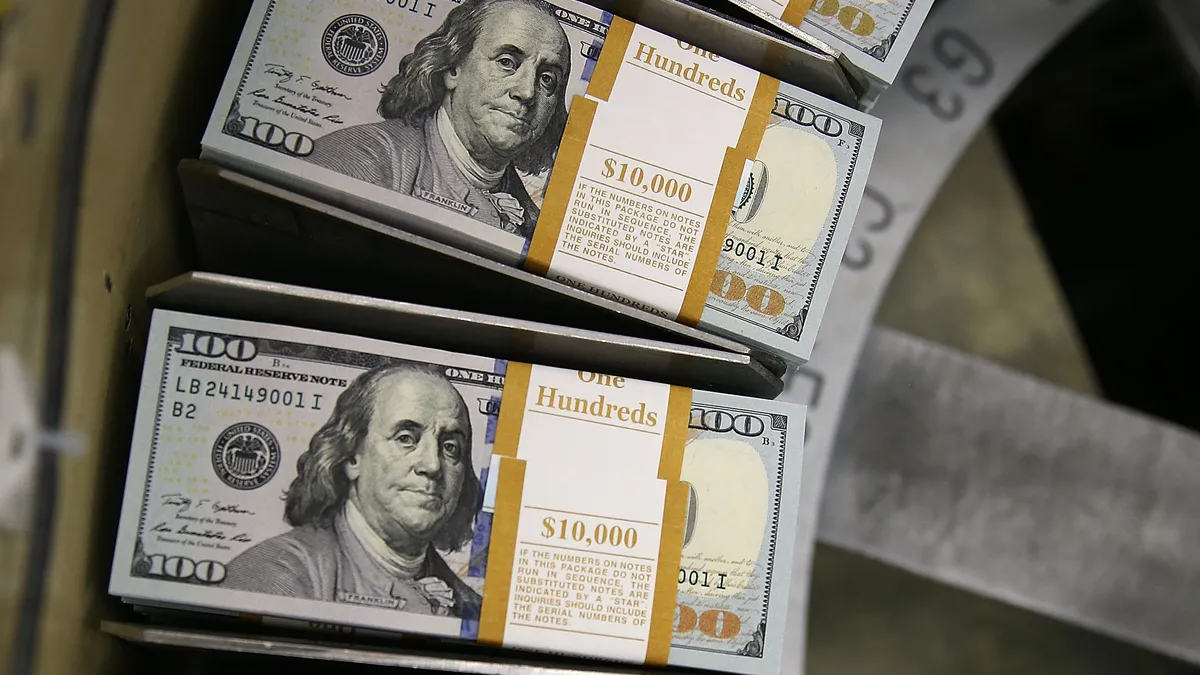Dive Brief:
-
By 2026, $995 billion is expected to be spent through BNPL payment options, up from an estimated $226 billion in 2021, according to a recent report by Juniper Research.
-
Consumers are adapting to the BNPL payments, with 55% of Americans having used the BNPL option as of March 2021, compared to 37% in July 2020, according to research by the Motley Fool. The deferred payment adoption is high among 18 to 24-year-olds and people above the age of 54 with a 62% and 98% growth rate, respectively, between July 2020 and March 2021, according to the Motley Fool research.
-
As the adoption of BNPL payments increases, regulators are keeping a close watch. In the U.K., the Financial Conduct Authority has proposed plans to bring BNPL providers under FCA's regulations and treat them as lenders rather than payments providers. Similar regulatory steps could be taken in the U.S. as well as BNPL payment adoption increases.
Dive Insight:
Money spent through the buy now, pay later payments market is expected to nearly quadruple — a 274% increase — between 2021 and 2026, Juniper research predicts.
Despite increasing regulations surrounding the sector, by 2026, BNPL payments will account for over 24% of global e-commerce transactions compared to just 9% in 2021, according to the report.
The increased adoption is “fueled by a greater appetite from users for credit to spread costs, particularly in the wake of the pandemic, which has put extreme pressure on user finances,” the research stated.
BNPL giants like Affirm, Klarna and Splitit experienced growth among their user base along with increasing valuation of their companies. Affirm went through an initial public offering (IPO) in January 2020 and was valued at more than $31 billion in April 2021, compared to a $23 billion valuation before the IPO. Klarna, the Swedish BNPL company, recently raised $639 million from Softbank, among other investors and is now valued at $45 billion.
Consumers and merchants alike are gravitating towards the BNPL payment option as it can provide low-risk money management for users and increased sales for the vendor, according to the research. Customers use the BNPL payment option “as a budget-management tool, crediting transparency and real-time monitoring of spending,” the Juniper research stated. Young consumers like millennials are gravitating more towards such payment options despite having a credit card to have a better view of interest rates and late fees they might incur.
Klarna customers can use the BNPL payment option at 60,000 retail stores like Macy's, Sephora and H&M in the U.S. and the company is in works for creating its own card offering to “add value and convenience to” its 18 million customers in the U.S., a Klarna spokesperson said in an email.
The Motley Fool surveyed 2,000 Americans in July 2020 and March 2021 regarding their BNPL payments habits and found that 45% of the respondents used BNPL to make a purchase that didn't fit their budget. According to research by the Motley Fool, “62% of buy now, pay later users think BNPL could replace their credit cards.”
“I think the BNPL payment option is a bit far away from replacing credit cards as of now,” Lily Varon, an analyst at Forrester, said in an interview. “People usually use it for larger ticket purchases and prefer using credit cards for day-to-day small-ticket transactions.”
A major hurdle for the mass adoption of the BNPL payments is the lack of its usability for in-store purchases. Companies like Splitit and Afterpay have started offering BNPL payment options for in-store purchases at select merchant stores. Affirm launched its debit card earlier this year which provides its customers with an option to use the BNPL payment option at Walmart and any other merchants that have integrated their point of sale (POS) with Affirm’s application programming interface (API).
Merchants can also leverage in-store QR payment options to connect a customer quickly to their preferred BNPL payment provider, the Juniper research stated.
Regulatory hurdles might also slow down the mass adoption of BNPL payments but demand for such payment methods will continue to grow, according to the research.
In the U.K., the Financial Conduct Authority announced earlier this year that it plans to tighten regulations on BNPL payments. The FCA argues that BNPL payment options urge consumers to spend more than they can afford to pay.
In the U.S., 31% of BNPL customers have incurred a late fee due to missing a payment, the Motley Fool research found.
The FCA regulation will govern BNPL companies as a lender rather than a payments provider and ask them to provide their users essential information regarding their payments plan.
“Changes are urgently needed to bring BNPL into regulation to protect consumers,” Christopher Woolard, chair of the review at the FCA said in the press release. “To ensure that there is secure provision of debt advice to help all those who may need it. So, it’s vital that we have a fair market that works for everyone.”
Some reports suggest similar regulatory steps are expected in the U.S. by the Consumer Finance Protection Bureau as the payments adoptions rate increases and BNPL companies spill into professional services.
“As a tool to split the cost for users, buy now pay later is ideally suited for high-cost items, as it enables users to seamlessly split large costs into smaller, more manageable payments,” Damla Sat, the co-author of the Juniper research said in the press release. “By 2026, these platforms will increasingly become the norm for lower-cost purchases as well; driven by user demand and eCommerce platform integrations.”











